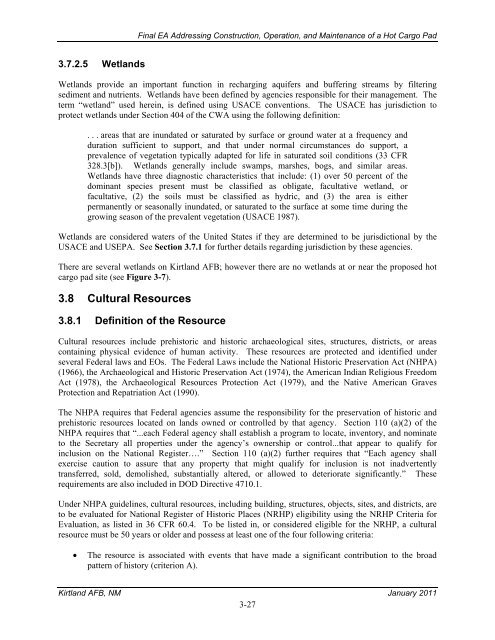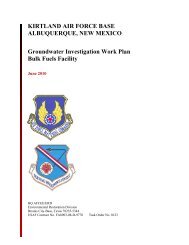Final FONSI and EA for hot cargo pad on Kirtland AFB - Kirtland Air ...
Final FONSI and EA for hot cargo pad on Kirtland AFB - Kirtland Air ...
Final FONSI and EA for hot cargo pad on Kirtland AFB - Kirtland Air ...
You also want an ePaper? Increase the reach of your titles
YUMPU automatically turns print PDFs into web optimized ePapers that Google loves.
<str<strong>on</strong>g>Final</str<strong>on</strong>g> <str<strong>on</strong>g>EA</str<strong>on</strong>g> Addressing C<strong>on</strong>structi<strong>on</strong>, Operati<strong>on</strong>, <str<strong>on</strong>g>and</str<strong>on</strong>g> Maintenance of a Hot Cargo Pad<br />
3.7.2.5 Wetl<str<strong>on</strong>g>and</str<strong>on</strong>g>s<br />
Wetl<str<strong>on</strong>g>and</str<strong>on</strong>g>s provide an important functi<strong>on</strong> in recharging aquifers <str<strong>on</strong>g>and</str<strong>on</strong>g> buffering streams by filtering<br />
sediment <str<strong>on</strong>g>and</str<strong>on</strong>g> nutrients. Wetl<str<strong>on</strong>g>and</str<strong>on</strong>g>s have been defined by agencies resp<strong>on</strong>sible <str<strong>on</strong>g>for</str<strong>on</strong>g> their management. The<br />
term “wetl<str<strong>on</strong>g>and</str<strong>on</strong>g>” used herein, is defined using USACE c<strong>on</strong>venti<strong>on</strong>s. The USACE has jurisdicti<strong>on</strong> to<br />
protect wetl<str<strong>on</strong>g>and</str<strong>on</strong>g>s under Secti<strong>on</strong> 404 of the CWA using the following definiti<strong>on</strong>:<br />
. . . areas that are inundated or saturated by surface or ground water at a frequency <str<strong>on</strong>g>and</str<strong>on</strong>g><br />
durati<strong>on</strong> sufficient to support, <str<strong>on</strong>g>and</str<strong>on</strong>g> that under normal circumstances do support, a<br />
prevalence of vegetati<strong>on</strong> typically adapted <str<strong>on</strong>g>for</str<strong>on</strong>g> life in saturated soil c<strong>on</strong>diti<strong>on</strong>s (33 CFR<br />
328.3[b]). Wetl<str<strong>on</strong>g>and</str<strong>on</strong>g>s generally include swamps, marshes, bogs, <str<strong>on</strong>g>and</str<strong>on</strong>g> similar areas.<br />
Wetl<str<strong>on</strong>g>and</str<strong>on</strong>g>s have three diagnostic characteristics that include: (1) over 50 percent of the<br />
dominant species present must be classified as obligate, facultative wetl<str<strong>on</strong>g>and</str<strong>on</strong>g>, or<br />
facultative, (2) the soils must be classified as hydric, <str<strong>on</strong>g>and</str<strong>on</strong>g> (3) the area is either<br />
permanently or seas<strong>on</strong>ally inundated, or saturated to the surface at some time during the<br />
growing seas<strong>on</strong> of the prevalent vegetati<strong>on</strong> (USACE 1987).<br />
Wetl<str<strong>on</strong>g>and</str<strong>on</strong>g>s are c<strong>on</strong>sidered waters of the United States if they are determined to be jurisdicti<strong>on</strong>al by the<br />
USACE <str<strong>on</strong>g>and</str<strong>on</strong>g> USEPA. See Secti<strong>on</strong> 3.7.1 <str<strong>on</strong>g>for</str<strong>on</strong>g> further details regarding jurisdicti<strong>on</strong> by these agencies.<br />
There are several wetl<str<strong>on</strong>g>and</str<strong>on</strong>g>s <strong>on</strong> Kirtl<str<strong>on</strong>g>and</str<strong>on</strong>g> <strong>AFB</strong>; however there are no wetl<str<strong>on</strong>g>and</str<strong>on</strong>g>s at or near the proposed <str<strong>on</strong>g>hot</str<strong>on</strong>g><br />
<str<strong>on</strong>g>cargo</str<strong>on</strong>g> <str<strong>on</strong>g>pad</str<strong>on</strong>g> site (see Figure 3-7).<br />
3.8 Cultural Resources<br />
3.8.1 Definiti<strong>on</strong> of the Resource<br />
Cultural resources include prehistoric <str<strong>on</strong>g>and</str<strong>on</strong>g> historic archaeological sites, structures, districts, or areas<br />
c<strong>on</strong>taining physical evidence of human activity. These resources are protected <str<strong>on</strong>g>and</str<strong>on</strong>g> identified under<br />
several Federal laws <str<strong>on</strong>g>and</str<strong>on</strong>g> EOs. The Federal Laws include the Nati<strong>on</strong>al Historic Preservati<strong>on</strong> Act (NHPA)<br />
(1966), the Archaeological <str<strong>on</strong>g>and</str<strong>on</strong>g> Historic Preservati<strong>on</strong> Act (1974), the American Indian Religious Freedom<br />
Act (1978), the Archaeological Resources Protecti<strong>on</strong> Act (1979), <str<strong>on</strong>g>and</str<strong>on</strong>g> the Native American Graves<br />
Protecti<strong>on</strong> <str<strong>on</strong>g>and</str<strong>on</strong>g> Repatriati<strong>on</strong> Act (1990).<br />
The NHPA requires that Federal agencies assume the resp<strong>on</strong>sibility <str<strong>on</strong>g>for</str<strong>on</strong>g> the preservati<strong>on</strong> of historic <str<strong>on</strong>g>and</str<strong>on</strong>g><br />
prehistoric resources located <strong>on</strong> l<str<strong>on</strong>g>and</str<strong>on</strong>g>s owned or c<strong>on</strong>trolled by that agency. Secti<strong>on</strong> 110 (a)(2) of the<br />
NHPA requires that “...each Federal agency shall establish a program to locate, inventory, <str<strong>on</strong>g>and</str<strong>on</strong>g> nominate<br />
to the Secretary all properties under the agency’s ownership or c<strong>on</strong>trol...that appear to qualify <str<strong>on</strong>g>for</str<strong>on</strong>g><br />
inclusi<strong>on</strong> <strong>on</strong> the Nati<strong>on</strong>al Register….” Secti<strong>on</strong> 110 (a)(2) further requires that “Each agency shall<br />
exercise cauti<strong>on</strong> to assure that any property that might qualify <str<strong>on</strong>g>for</str<strong>on</strong>g> inclusi<strong>on</strong> is not inadvertently<br />
transferred, sold, demolished, substantially altered, or allowed to deteriorate significantly.” These<br />
requirements are also included in DOD Directive 4710.1.<br />
Under NHPA guidelines, cultural resources, including building, structures, objects, sites, <str<strong>on</strong>g>and</str<strong>on</strong>g> districts, are<br />
to be evaluated <str<strong>on</strong>g>for</str<strong>on</strong>g> Nati<strong>on</strong>al Register of Historic Places (NRHP) eligibility using the NRHP Criteria <str<strong>on</strong>g>for</str<strong>on</strong>g><br />
Evaluati<strong>on</strong>, as listed in 36 CFR 60.4. To be listed in, or c<strong>on</strong>sidered eligible <str<strong>on</strong>g>for</str<strong>on</strong>g> the NRHP, a cultural<br />
resource must be 50 years or older <str<strong>on</strong>g>and</str<strong>on</strong>g> possess at least <strong>on</strong>e of the four following criteria:<br />
<br />
The resource is associated with events that have made a significant c<strong>on</strong>tributi<strong>on</strong> to the broad<br />
pattern of history (criteri<strong>on</strong> A).<br />
Kirtl<str<strong>on</strong>g>and</str<strong>on</strong>g> <strong>AFB</strong>, NM January 2011<br />
3-27
















